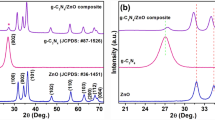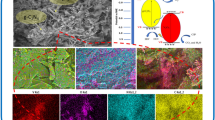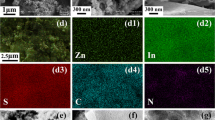Abstract
A series of g-C3N4@ZrO2 composites with a porous structure are synthesized by mixing MOF-808 precursor and melamine by thermal decomposition in air. The catalyst demonstrated excellent photocatalytic activity in the degrading of ciprofloxacin (CIP) and rhodamine B (RhB) dyes under visible light. The degradation of CIP by the catalyst corresponds to first-order kinetics and CZ-100 has the best degradation property, and almost nearly degrades RhB within 50 min. Radical trapping experiments indicated that ·O2– and h+ were the main factors to the degrading of RhB. According to the relevant literature, the possible ways of CIP degradation are proposed, the intermediate reaction products in the photocatalytic degradation process are analyzed, and the photoelectrochemical properties of the materials are investigated by characterization techniques such as photoluminescence emission spectroscopy and electrochemical impedance. The main reason of catalytic performance improvement is to facilitate electron and hole effective separation, and finally the probable photocatalytic mechanism of g-C3N4@ZrO2 is suggested. After 5 cycle experiments, the degradation rate of the material still reached more than 85%. It shows that g-C3N4@ZrO2 has good photocatalytic stability and repeatability, and has broad application prospects in water pollution control.













Similar content being viewed by others
References
Q. Wang, Q. Gao, A.M. Al-Enizi, A. Nafady, S. Ma, Recent advances in MOF-based photocatalysis: environmental remediation under visible light. Inorg. Chem. Front. 7(2), 300–339 (2020)
M. dAadil, M. Mahmood, M.F. Warsi, I.A. Alsafari, S. Zulfiqar, M. Shahid, Fabrication of MnO2 nanowires and their nanohybrid with flat conductive matrix for the treatment of industrial effluents. FlatChem 30, 100316 (2021)
C. Karthikeyan, P. Arunachalam, K. Ramachandran, A.M. Al-Mayouf, S. Karuppuchamy, Recent advances in semiconductor metal oxides with enhanced methods for solar photocatalytic applications. J. Alloys Compd. 828, 154281 (2020)
X. Feng, Z. Yu, Y. Sun, M. Shan, R. Long, X. Lie, 3D MXene/Ag2S material as Schottky junction catalyst with stable and enhanced photocatalytic activity and photocorrosion resistance. Sep. Purif. Technol. 266, 118606 (2021)
S. Gautam, H. Agrawal, M. Thakur, A. Akbari, H. Sharda, R. Kaur, M. Amini, Metal oxides and metal organic frameworks for the photocatalytic degradation: a review. J. Environ. Chem. Eng. 8(3), 103726 (2020)
Y.L. Wang, S. Zhang, Y.F. Zhao, J. Bedia, J.J. Rodriguez, C. Belver, UiO-66-based metal organic frameworks for the photodegradation of acetaminophen under simulated solar irradiation. J. Environ. Chem. Eng. 9(5), 106087 (2021)
T. Chen, S. Han, Z. Wang, H. Gao, L. Wang, Y. Deng, C. Wan, Y. Tian, Q. Wang, G. Wang, G. Li, Modified UiO-66 frameworks with methylthio, thiol and sulfonic acid function groups: The structure and visible-light-driven photocatalytic property study. Appl. Catal. B 259, 118047 (2019)
S. Mao, Y. Zou, G. Sun, L. Zeng, Z. Wang, D. Ma, Y. Guo, Y. Cheng, C. Wang, J. Shi, Thio linkage between CdS quantum dots and UiO-66-type MOFs as an effective transfer bridge of charge carriers boosting visible-light-driven photocatalytic hydrogen production. J. Colloid Interface Sci. 581, 1–10 (2021)
Q. Liang, J. Chen, F. Wang, Y. Li, Transition metal-based metal-organic frameworks for oxygen evolution reaction. Coord. Chem. Rev. 424, 213488 (2020)
M. Ismael, A review on graphitic carbon nitride (g-C3N4) based nanocomposites: synthesis, categories, and their application in photocatalysis. J. Alloys Compd. 846, 156446 (2020)
Y. Shi, L. Li, Z. Xu, H. Sun, F. Guo, W. Shi, One-step simple green method to prepare carbon-doped graphitic carbon nitride nanosheets for boosting visible-light photocatalytic degradation of tetracycline. J. Chem. Technol. Biotechnol. 96(11), 3122–3133 (2021)
S. Thaweesak, S. Wang, M. Lyu, M. Xiao, P. Peerakiatkhajohn, L. Wang, Boron-doped graphitic carbon nitride nanosheets for enhanced visible light photocatalytic water splitting. Dalton Trans. 46(32), 10714–10720 (2017)
Y. Yuan, L. Zhang, J. Xing, M.B. Utama, X. Lu, K. Du, Y. Li, X. Hu, S. Wang, A. Genç, R. Dunin-Borkowski, J. Arbioldf, Q. Xiong, High-yield synthesis and optical properties of g-C3N4. Nanoscale 7(29), 12343–12350 (2015)
F. Guo, X. Huang, Z. Chen, H. Sun, L. Chen, Prominent co-catalytic effect of CoP nanoparticles anchored on high-crystalline g-C3N4 nanosheets for enhanced visible-light photocatalytic degradation of tetracycline in wastewater. Chem. Eng. J. 395, 125118 (2020)
Y. Zhen, C. Yang, H. Shen, W. Xue, C. Gu, J. Feng, Y. Zhang, F. Fu, Y. Liang, Photocatalytic performance and mechanism insights of a S-scheme g-C3N4/Bi2MoO6 heterostructure in phenol degradation and hydrogen evolution reactions under visible light. Phys. Chem. Chem. Phys. 22(45), 26278–26288 (2020)
S. Kang, M. He, M. Chen, Z. Wang, Z. Sun, H. Dang, X. Chang, M. Dong, P. Liu, L. Cui, Polymeric structure optimization of g-C3N4 by using confined argon-assisted highly-ionized ammonia plasma for improved photocatalytic activity. J. Colloid Interface Sci. 556, 214–223 (2019)
R. Senthil, S. Osman, J. Pan, X. Liu, Y. Wu, Recent progress on porous carbon derived from Zn and Al based metal-organic frameworks as advanced materials for supercapacitor applications. J. Energy Storage. 44, 103263 (2021)
M. Xu, X. Zhao, H. Jiang, S. Chen, P. Huo, MOFs-derived C-In2O3/g-C3N4 heterojunction for enhanced photoreduction CO2. J. Environ. Chem. Eng. 9(6), 106469 (2021)
S. Liu, D. Chi, Q. Zou, Y. Ma, R. Chen, K. Zhang, MOFs-Derived MoS2/C3N4 composites with highly efficient charge separation for photocatalytic H2 evolution. Inorganica Chim. Acta 533, 120787 (2022)
Y. Feng, T. Yan, T. Wu, N. Zhang, Q. Yang, M. Sun, L. Yan, B. Du, Q. Wei, A label-free photoelectrochemical aptasensing platform base on plasmon Au coupling with MOF-derived In2O3@g-C3N4 nanoarchitectures for tetracycline detection. Sens. Actuators B Chem. 298, 126817 (2019)
W. Zou, B. Deng, X. Hu, Y. Zhou, Y. Pu, S. Yu, K. Ma, J. Sun, H. Wan, L. Dong, Crystal-plane-dependent metal oxide-support interaction in CeO2/g-C3N4 for photocatalytic hydrogen evolution. Appl. Catal. B. 238, 111–118 (2018)
R. Tang, D. Gong, Y. Deng, S. Xiong, J. Zheng, L. Li, Z. Zhou, L. Su, J. Zhao, π-π stacking derived from graphene-like biochar/g-C3N4 with tunable band structure for photocatalytic antibiotics degradation via peroxymonosulfate activation. J. Hazard. Mater. 423, 126944 (2022)
H. Huang, K. Hu, C. Xue, Z. Wang, Z. Fang, L. Zhou, M. Sun, Z. Xua, J. Kou, L. Wang, C. Lu, Metal-free π-conjugated hybrid g-C3N4 with tunable band structure for enhanced visible-light photocatalytic H2 production. J. Mater Sci Technol. 87, 207–215 (2021)
Y. Duan, L. Deng, Z. Shi, X. Liu, H. Zeng, H. Zhang, J. Crittenden, Efficient sulfadiazine degradation via in-situ epitaxial grow of Graphitic Carbon Nitride (g-C3N4) on carbon dots heterostructures under visible light irradiation: Synthesis, mechanisms and toxicity evaluation. J. Colloid Interface Sci. 561, 696–707 (2022)
D. Gogoi, A. Shah, M. Qureshi, A. Golder, N. Peela, Silver grafted graphitic-carbon nitride ternary hetero-junction Ag/gC3N4 (Urea)-gC3N4 (Thiourea) with efficient charge transfer for enhanced visible-light photocatalytic green H2 production. Appl. Surf. Sci. 558, 149900 (2021)
X. Liu, H. Ji, S. Li, W. Liu, Graphene modified anatase/titanate nanosheets with enhanced photocatalytic activity for efficient degradation of sulfamethazine under simulated solar light. Chemosphere 233, 198–206 (2019)
X. Yu, J. Xie, Q. Liu, H. Dong, Y. Li, The origin of enhanced photocatalytic activity in g-C3N4/TiO2 heterostructure revealed by DFT calculations. J. Colloid Interface Sci. 593, 133–141 (2021)
T. Zhang, Q. Yin, M. Zhang, S. Zhang, Y. Shao, L. Fang, Q. Yan, X. Sun, Enhanced photocatalytic activity of AgBr photocatalyst via constructing heterogeneous junctions with reduced graphene. J. Mater. Sci. 32(11), 15331–15342 (2021)
X. Bi, S. Yu, E. Liu, L. Liu, K. Zhang, J. Zang, Y. Zhao, Construction of g-C3N4/TiO2 nanotube arrays Z-scheme heterojunction to improve visible light catalytic activity. Colloids Surf. A Physicochem. Eng. Asp. 603, 125193 (2020)
J. Guo, H. Sun, X. Yuan, L. Jiang, Z. Wu, H. Yu, N. Tang, M. Yu, M. Yan, J. Liang, Photocatalytic degradation of persistent organic pollutants by Co-Cl bond reinforced CoAl-LDH/Bi12O17Cl2 photocatalyst: mechanism and application prospect evaluation. Water Res. 219, 118558 (2022)
R. Wang, Y. Hu, J. Du, L. Xu, Y. Fu, Boosting the visible-light activity of ZrO2/g-C3N4 by controlling the crystal structure of ZrO2. J. Mater. Res. 36(15), 3086–3095 (2021)
T.D. Munusamy, C.S. Yee, M.R. Khan, Construction of hybrid g-C3N4/CdO nanocomposite with improved photodegradation activity of RhB dye under visible light irradiation. Adv. Powder Technol. 31(7), 2921–2931 (2020)
L. Zhu, J. Luo, G. Dong, Y. Lu, Y. Lai, J. Liu, G. Chen, Y. Zhang, Enhanced photocatalytic degradation of organic contaminants over a CuO/g-C3N4 p–n heterojunction under visible light irradiation. RSC Adv. 11, 33373–33379 (2021)
Z. Wu, Y. Liang, X. Yuan, D. Zou, J. Fang, L. Jiang, J. Zhang, H. Yang, Z. Xiao, MXene Ti3C2 derived Z–scheme photocatalyst of graphene layers anchored TiO2/g–C3N4 for visible light photocatalytic degradation of refractory organic pollutants. Chem. Eng. J. 394, 124921 (2020)
H. Shao, P. Yao, Y. Chen, Y. Yao, G. Li, X. Liao, Ball-milling method encapsulated α-Fe2O3 into g-C3N4 as efficient and stable photo-catalysts. New J. Chem. 45, 16092–16100 (2021)
P. Xia, B. Zhu, B. Cheng, J. Yu, J. Xu, 2D/2D g-C3N4/MnO2 nanocomposite as a direct Z-scheme photocatalyst for enhanced photocatalytic activity. ACS Sustain. Chem. Eng. 6(1), 965–973 (2018)
Y. Zhu, Y. Cui, B. Xiao, J. Yang, H. Li, Z. Chen, Z-scheme 2D/2D g-C3N4/Sn3O4 heterojunction for enhanced visible-light photocatalytic H2 evolution and degradation of ciprofloxacin. Mater. Sci. Semicond. Process. 129, 105767 (2021)
Acknowledgements
This work was supported by National Natural Science Foundation of China (No. 22072038), the Natural Science Foundation of Hubei Province Education Committee, China (D20213102) and Graduate Student Innovation Research Foundation of Hubei Normal University (2022057).
Funding
National Natural Science Foundation of China (No. 22072038); the Natural Science Foundation of Hubei Province Education Committee, China (D20213102); Graduate Student Innovation Research Foundation of Hubei Normal University (2022057).
Author information
Authors and Affiliations
Contributions
All authors contributed to the study conception and design. Material preparation, data collection and analysis were performed by YY, YZ, HH, XL and SY. The first draft of the manuscript was co-authored by YY and YZ and all authors commented on previous versions of the manuscript. All authors read and approved the final manuscript.
Corresponding author
Ethics declarations
Conflict of interest
The authors declare that they have no known competing financial interests or personal relationships that could have appeared to influence the work reported in this paper.
Research data policy and data availability statements
The materials used and analyzed during the current study are available from the corresponding author on reasonable request.
Additional information
Publisher's Note
Springer Nature remains neutral with regard to jurisdictional claims in published maps and institutional affiliations.
Rights and permissions
Springer Nature or its licensor (e.g. a society or other partner) holds exclusive rights to this article under a publishing agreement with the author(s) or other rightsholder(s); author self-archiving of the accepted manuscript version of this article is solely governed by the terms of such publishing agreement and applicable law.
About this article
Cite this article
Yang, Y., Zhao, Y., Hu, H. et al. Synthesis and characterization of g-C3N4@ZrO2 composites through calcination method for enhanced photocatalytic activities. J Mater Sci: Mater Electron 34, 946 (2023). https://doi.org/10.1007/s10854-023-10422-w
Received:
Accepted:
Published:
DOI: https://doi.org/10.1007/s10854-023-10422-w




